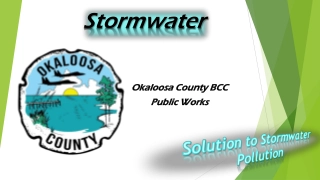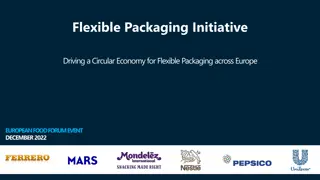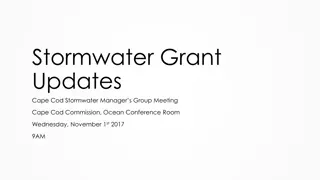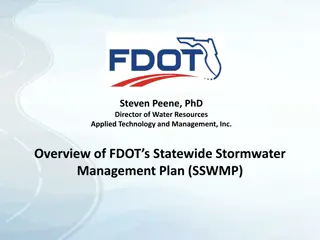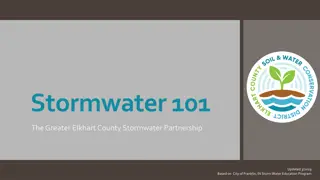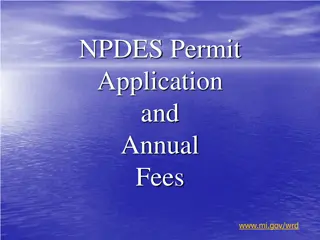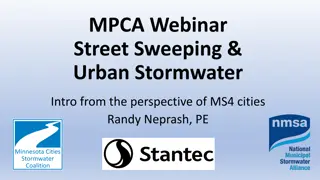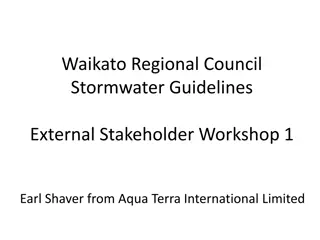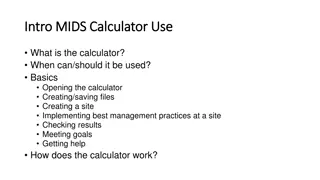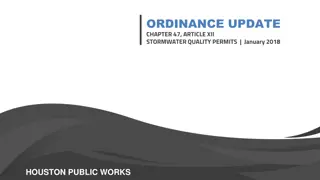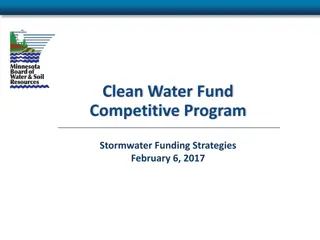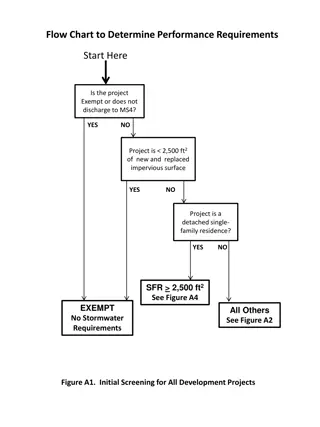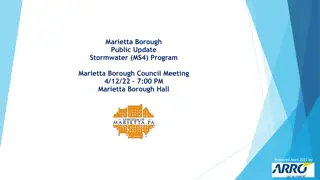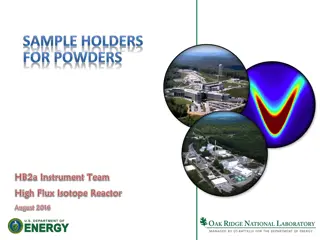Flexible Framework for Stormwater Lids Modeling
A new flexible framework for forward and inverse modeling of stormwater lids is presented. It includes governing equations, hydraulic and contaminant transport, numerical methods, and demonstration cases for various green infrastructure components. The importance of different processes in modeling is discussed along with inverse modeling and uncertainty assessment.
Download Presentation

Please find below an Image/Link to download the presentation.
The content on the website is provided AS IS for your information and personal use only. It may not be sold, licensed, or shared on other websites without obtaining consent from the author.If you encounter any issues during the download, it is possible that the publisher has removed the file from their server.
You are allowed to download the files provided on this website for personal or commercial use, subject to the condition that they are used lawfully. All files are the property of their respective owners.
The content on the website is provided AS IS for your information and personal use only. It may not be sold, licensed, or shared on other websites without obtaining consent from the author.
E N D
Presentation Transcript
A FLEXIBLE FRAMEWORK FOR FORWARD AND INVERSE MODELING OF STORMWATER LIDS Arash Massoudieh Mahdi Maghrebi The Catholic University of America Washington, DC
Overview Why a new framework? Governing Equations Hydraulic Particle Transport Contaminant transport Numerical method Demonstration cases Bioretention (hydraulic) Infiltration basin (hydraulic) Permeable pavement (hydraulic) Wetland/stream (hydraulic + reactive transport) Small catchment (hydraulic, transport) Conclusions
Green Infrastructure modeling Diverse system configurations Need to choose/adjust the levels of complexity The importance of particular processes depends on: the goal of simulation contaminant of concern time scale of interest Inverse Modeling/Uncertainty assessment Sheet flow Pond Substrate Storage Pipe Native Soil Ground water
Block-Connector conceptualization Inflow A=85.71 A=61.67 A=207.14 5 19 12 19 18 Z=158.06 Z=158.13 10 16 Z=157.98 11 4 18 4 15 9 3 10 3 17 14 2 8 9 2 16 24 Engineered soil 13 1 7 8 1 15 6 12 0 7 14 0 Z=157.37 15 Aggregate6 PVC 25 5 11 17 20 Z=157.18 A=5, Depth=1000 Z=157.22 24 21 Slope=0.5 % Z=157.0 6 13 Z=157.08 20 Z=156.53 Z=156.99 22 23 24 21 22 23 26 Z=0 Z=156.02 A=182.14 A=98.00 A=20.97 44 37 25 46 45 Z=155.72 Z=155.86 43 30 43 Z=155.66 36 37 31 42 29 42 36 35 30 41 35 29 34 28 41 24 Engineered soil 40 34 33 27 28 40 39 33 27 32 26 39 Z=155.05 32 38 Z=154.78 44 48 Z=154.9 47 45 31 Z=154.82 38 15 Aggregate Z=154.78 Z=154.67 49 50 51 52 48 47 46 12 PVC Slope=0.5 % A=100, Depth=10000 49 Z=154.73 Z=0 Z=0
Governing Equations - Hydraulics nj dS dt ns Water Balance = + i Q Q , , s j i ij = = 1 1 j j ( ) Head-Storage constitutive theory = ; h f S other factors i i Head-Flow constitutive theory ( ) = , ; Q f h h other factors ij i j
Constitutive Equations +user-defined blocks
Constitutive Equation (hydraulics) Constitutive relations are not hard-coded. Default relationships for known elements are available Soil Pond Storage Catchment Manhole Darcy Stream ( )( ) h h 2 Pipe Soil ( ) h h h h 2 H h z d h z N/A N/A 2 2 2 ( ) ( ) ( ) m m m m i j 1/ e m i i i i 1/ e m 1 1 i j AK S S 2 1 1 AK S S 1/ e m i j 2 1 1 AK S S 1/ e m 2 1 1 AK S S s e s e s e d s e d d ( ) pos h h W dn ( ) y 5/3 i j 5/3 + h h y y i d W dn h h 2 ( ) h h Pond 5/3 h h m + ( ) pos h z i j i j W dn h h y y W dn i j 1/ e m 2 1 1 AK S S ( ) y i j 5/3 2 AK i j ( ) pos h h i j i j i i W dn K ( ) y 5/3 s e 2 d j i s d d i 2 d d s d j d ( )( ) ( ) pos h h 2 H h z d h z h h 2 ( ) m j i i i i i 1/ e m 2 1 1 AK S S if z z K A horizontal i j K horizontal h h ( ) pos h z s e i j s W dn d ( ) y s d 5/3 i j Pipe N/A Storage j j K h h h h 2 ( ) m s i j h z j 1/ e m 2 1 1 AK S S else i j d d K A vertical s e i i K vertical d s d s d ( ) ( ) pos h h pos h h ( ) pos h z ( ) W dn pos h z W dn W dn W dn ( ) y ( ) y ( ) y 5/3 5/3 5/3 ( ) y i j i j 5/3 j j N/A N/A Catchment i i ( ) pos h z W dn i i d d ( ) y j 5/3 d i i i d ( ) pos h h i ( ) pos h h W dn W dn ( ) y d ( ) y 5/3 5/3 j i j i j j d d ( ) pos h z ( ) pos h z W dn W dn ( ) y ( ) y 5/3 5/3 Pipe Pipe Pipe Pipe Pipe Manhole j j i i j i d d ( ) pos h h h h h h i j K A horizontal N/A Pipe Darcy i j i j h h h h AK AK 2 ( ) s d m i j i j 2 AK 1/ e m 2 1 1 AK S S s s d d s h h d s e d i j K A vertical s d 5/3 5/3 + ( ) + pos h h y y ( ) pos h z h h y y W dn W dn W dn ( ) y i j i j ( ) 5/3 pos h z W dn ( ) y i j i j j j 5/3 N/A N/A Pipe Stream j j 2 d j 2 d d j d 5/3 + ( ) pos h h y y W dn j i i j 2 d S-H relationships Pond Storage Catchment Manhole Darcy Stream Soil ( ) ( )/ / S A 1 / / / / S A S A S A S A ( ) sS 1/ n ( ) s s ( ) + /(1 ) n n n 1 / z S S s s s s s s s / S V s e s s s
Particle Transport capacity d S mobility G nj nj ( ) ( ) = Q Q G , , i k dt i k H Q Q G H , , k ij ij j k ij ij i k = = 1 1 j j Advection , , , s i j k D d nj nk nk ( ) + + K K G G G G k k , , , , , , k k i k i k k j k i k = = = 1 1 1 k k j ij ( . . ) massexchangebetween phases e g mobile phase and attached phase / dispersion diffusion User-specified number of particle types User-specified number of phases
Coupled dissolved/particle facilitated constituent fate, reaction and transport Coupled particle-bound aqueous transport is important because the main removal processes in many LIDs is particle settling/filtration c capa ity d S G C nj nj ( ) ( ) = Q Q G C , , , , l i k i k i k H Q Q G C H , , , l j k , , , l i k k ij ij j k ij ij i k dt = = 1 1 j j advection , , , s i j k D d nj nk nk ( ) + + K K G C G C G C G C k k , , , , l i k , , , , l i k , , , l j k , , , l i k k k i k i k k j k i k = = = 1 1 1 k k j ij mass exchange duetocolloidexchange / Dispersion Diffusion C C nr + + , , l i k , , l i k f R , , k k k k rl r = 1 r k k / transformation reaction adsorption desorption User-specified number of chemical species User-specified reaction network
Other processes Evaporation/Vapor exchange Build-up (exponential, linear, user-defined) Wash-off (Diffusive, flow-dependent, user-defined) Atmospheric Flux (e.g. Aeration) In progress: Transpiration and plant uptake Clogging
Reactions [??] [??] + ?? [??] + + + : AerobicOM decomposition OM O CO H O NH ????= ?? 2 2 2 3 [??] + ?? [??3] [??3] + ?? [??] ????= ?? + : Nitrification NH O NO [??] + ??? 3 2 3 ???? + + + + Denitrification OM NO N CO H O N H [??3] [??] [??] + ?? ?? 3 2 2 2 3 = ????? [??3] + ??? [??] + ??
Numerical Algorithm Implicit, Newton-Raphson with partial Jacobian evaluation Adaptive time-step C++ We are working on a GUI
Framework features User-defined reaction kinetics User-defined particle-medium interaction/settling Deterministic (GA) and stochastic (Bayesian-MCMC) parameter estimation User-defined atmospheric exchange, build-up, wash-off
Examples: St. Francis Bio-retention basin, Cincinnati, Ohio
Permeable Pavement System, Louisville, KT Lee et al., 2005
Reactive transport in a stream Initial DO: 8.5mg/L Initial NO3: 0 + + + : AerobicOM decomposition OM O + + CO H O NH 2 2 2 3 : Nitrification NH O NO 3 2 3 + + + Denitrification OM NO N CO H O N H 3 2 2 2 3 [??] [??] ????= ?? [??] + ?? [??] + ?? [??3] [??3] + ?? [??] ????= ?? [??] + ??? [??3] [??3] + ??? [??] ?? ????= ????? [??] + ?? [??] + ??
Infiltration Basin and GW recharge =10 2.5 m Pond Day 3 Day 9 Day 1
100x100m impervious surface-channel + wash-off Initial build-up of 1000mg/m2 of an imaginary contaminant with diffusive wash-off Depression storage 0.005m/m2 No infiltration
Summery LIDMod provide a flexible tool to assess the short-term and long-term performance of LIDs User-defined hydraulic relationship User-defined particle/colloid transport and retention User-defined reactions User-defined build-up and wash-off User-defined atmospheric exchange The framework is written to allow easy expansion Scripting language is liberating but not easy to use for every user Different level of complexity can be represented Inverse modeling need more computational speed
Thank you! If you think you have some applications for the program contact: massoudieh@cua.edu


